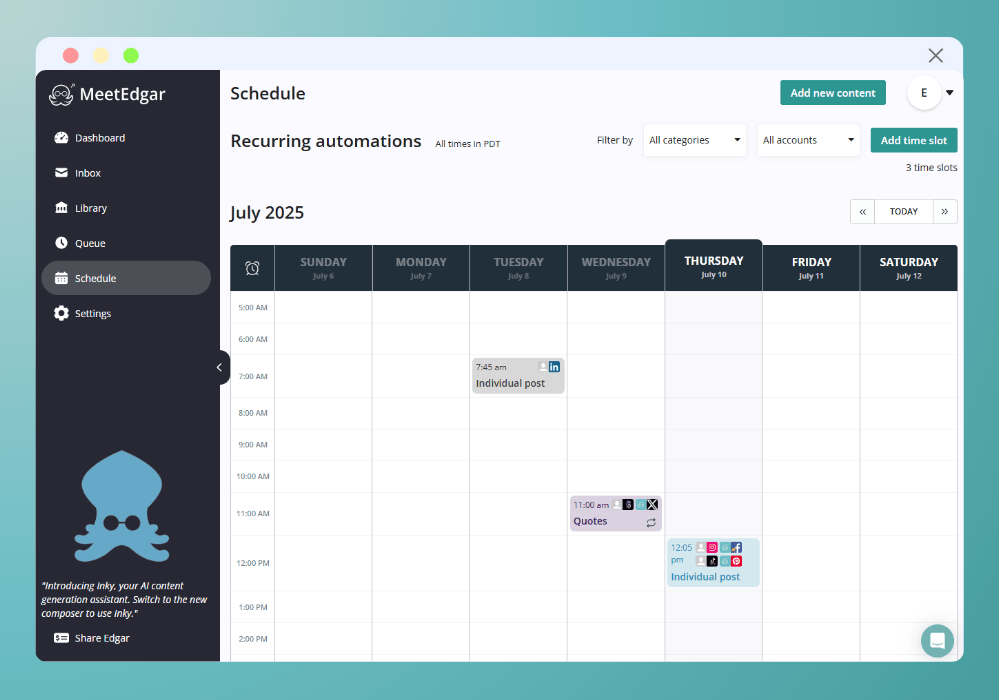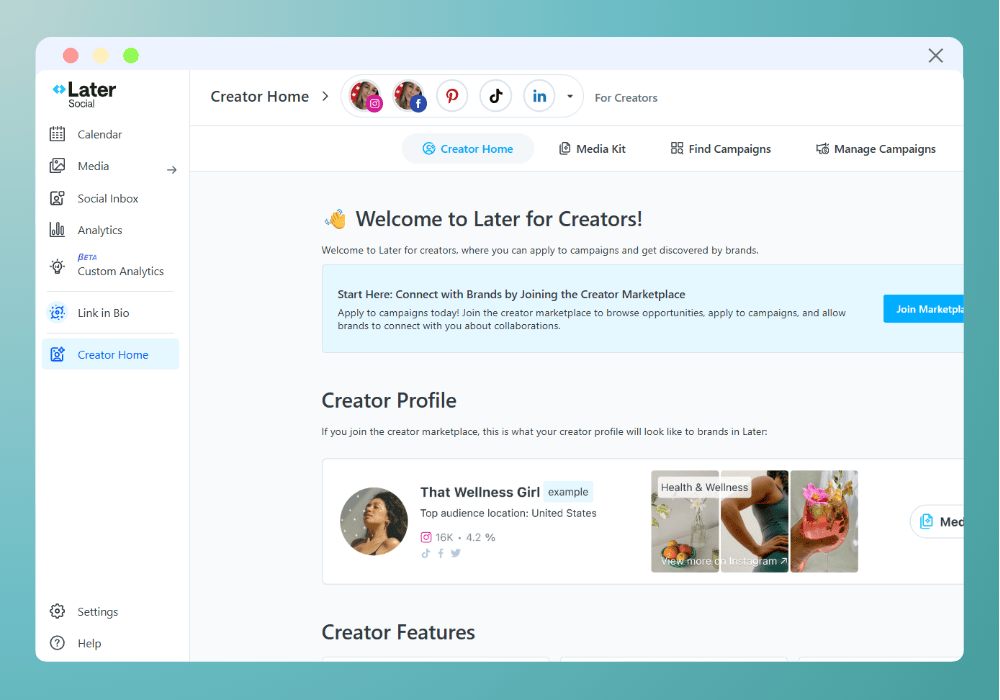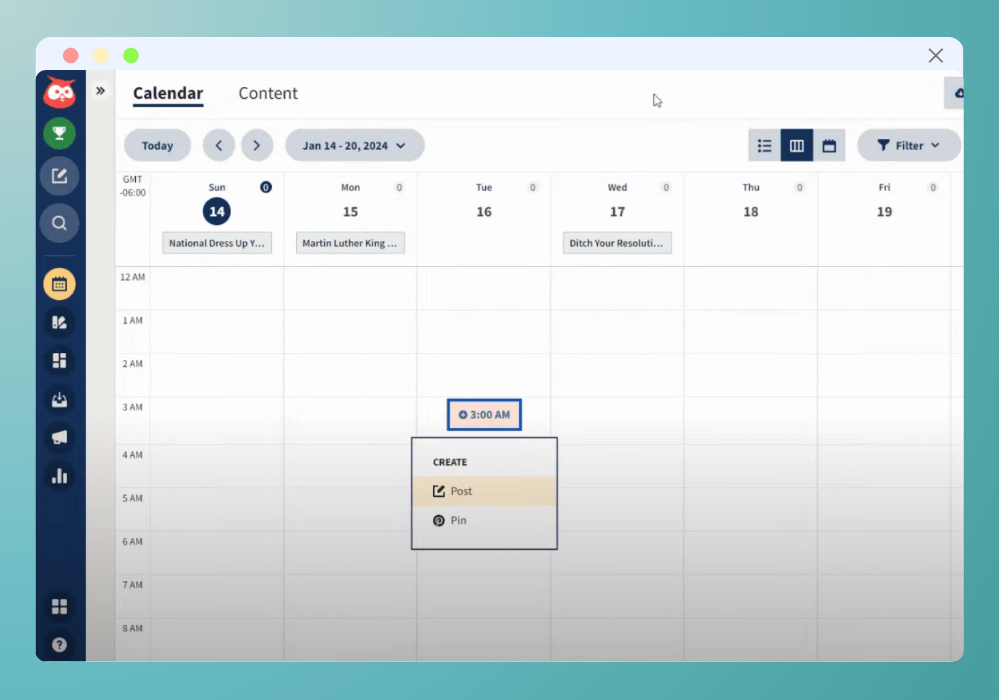Table of Contents:
Choosing the Right Social Media Planner for Your Business

Table of Contents:
It’s Monday morning, and you’re frantically searching for that image you saved somewhere for today’s Instagram post. You can’t remember if you’ve already posted on LinkedIn or TikTok. Sound familiar?
Growing a brand on social media isn’t easy. Especially when you’re managing multiple platforms, before you know it, hours have passed, and you still haven’t posted as much as you planned. Many business owners spend countless hours every week managing social media manually — time that could be better spent actually growing their business.
That’s where a social media planner comes in. It’s a tool that helps you schedule, organize, and publish content across all your social channels from one place. Instead of logging into five different apps every day, you can plan everything ahead, stay consistent, and save tons of time.
This guide will walk you through a simple, step-by-step process for choosing the best social media planner for your business — based on your size, budget, and goals. By the end, you’ll know exactly which features matter most and which tools are worth your attention.
Step 1: Define Your Business Needs and Goals (The Foundation)
Before exploring any tool, you need clarity on what you're actually trying to accomplish. The right planner for a solo entrepreneur looks very different from what a marketing agency needs.
Identify Your Platforms
Start by listing which social platforms you're currently active on and which ones you plan to expand to in the next six months. Are you focused on Instagram and Facebook for visual storytelling? LinkedIn for B2B networking? TikTok for reaching younger audiences? Pinterest for driving website traffic?
Your platform priorities directly impact which planner you should choose. Some tools excel at Instagram and Facebook but offer limited TikTok functionality. Others specialize in professional networks like LinkedIn. Make your list now—it's your first filtering criterion.
Determine Your Team Size and Workflow
Your team structure shapes your tool requirements dramatically.
Solo entrepreneurs and small businesses should prioritize affordability and simplicity. You need an all-in-one solution that's intuitive enough to use without extensive training. Features like complex approval workflows would just slow you down.
Agencies and large teams require robust collaboration features. You need clearly defined user roles (who can draft, who can edit, who gives final approval), approval workflows to maintain quality control, and potentially white-label reporting capabilities to present branded analytics to clients.
Be honest about your current situation and where you'll be in twelve months. Switching platforms mid-year is disruptive, so choose a tool that can grow with you.
Set Your Content Goals
Why are you even on social media? This isn't a philosophical question—it directly impacts which features matter most. Your primary purpose shapes which features become non-negotiable.
If you're focused on brand awareness and community building, you'll want strong scheduling capabilities and tools for consistent posting. If your goal is lead generation, look for tools with link tracking and conversion metrics. If customer support is your priority, you'll need robust inbox management and social listening features.
Define your top two goals. This clarity prevents you from paying for advanced features you'll never use.
Establish Your Budget
Be specific about what you can afford monthly or annually. Social media planners range from free plans with limited features to enterprise solutions costing several hundred dollars per month.
Setting a clear budget range (for example, $0-20, $20-100, or $100+) helps you immediately eliminate options that aren't financially viable. Remember to factor in potential growth—can you afford a higher tier if your business expands?
Step 2: Key Features to Look For (The Checklist)
Now that you understand your needs, let's explore the specific features that separate excellent planners from mediocre ones. Use this as your evaluation checklist when testing different platforms.
Core Planning and Scheduling
Visual Calendar: A drag-and-drop visual calendar is essential for seeing your content at a glance. You should be able to easily move posts around, identify gaps in your schedule, and ensure balanced content across platforms. The best calendars offer both month-view and week-view options.
Auto-Publishing: This is where the magic happens. Auto-publishing means your content goes live automatically at your scheduled time without any manual intervention. This feature is especially critical for Instagram, which historically required manual phone notifications. Verify that your chosen tool offers true auto-publishing, not just push notifications reminding you to post manually.
Content Library and Storage: Can you save drafts, store your media files, and keep caption templates handy? Think of this as your content vault. A good content library means you're not constantly re-uploading the same brand images or rewriting similar captions from scratch. The best planners let you store and categorize assets so you can find exactly what you need in seconds rather than searching through countless folders. Also, make sure to know if there is any limitation, as not every planner will offer unilimited library.
Platform Functionality
Multi-Platform Support: How many social channels can you manage from one dashboard? The ideal planner should cover all your priority platforms. At minimum, you'll want support for the major players (Facebook, Instagram, Twitter/X, LinkedIn). Note that not all social media platform will offer 3rd party access, which limit planner tools to offer integration, but most major platforms offers API access.
Platform-Specific Features: Generic scheduling isn't enough anymore. Your planner should accommodate platform-specific content types. Can you schedule Instagram Carousels with multiple images? Does it support TikTok video uploads directly? Can you tag other LinkedIn users or companies in your posts? These details matter for maximizing engagement on each platform.
Collaboration and Workflow (Crucial for Teams)
User Roles and Permissions: If you have a team, you need granular control over who can do what. Can you assign specific roles like Content Creator, Editor, and Administrator? Can you restrict certain team members to specific social accounts while giving others full access? This prevents accidental publishing and maintains accountability.
Approval Flow: For agencies and brands with multiple stakeholders, a defined approval process is non-negotiable. Content should move through clear stages: Draft, Pending Review, Approved, and Scheduled. Managers need visibility into what's awaiting approval, and team members need quick feedback loops. The best systems include comment threads so reviewers can suggest specific changes without confusing email chains.
Analytics and Reporting
Performance Metrics: Your planner should track meaningful metrics beyond vanity numbers. Look for tools that monitor engagement rates, reach, follower growth, best posting times, and top-performing content types. The data should help you understand what's working so you can do more of it.
Custom Reports: Can you generate professional-looking reports quickly? Agencies especially need white-label reporting capabilities to present branded analytics to clients. Look for exportable PDF reports, customizable date ranges, and the ability to compare performance across time periods.
Other Essential Integrations
Image and Design Tools: Seamless integration with design platforms like Canva or Adobe Express saves enormous time. The best planners let you create or edit images directly within the platform without switching between multiple tabs and tools.
Social Listening: More advanced planners include social listening capabilities to track brand mentions, monitor competitor activity, and identify trending topics in your industry. While not essential for beginners, this becomes increasingly valuable as your social presence grows.
Planner Recommendations by Business Type (The Comparison)
Let's translate everything into actionable recommendations. Here are the top social media planners organized by business type and specific needs.
Best for Solopreneurs & Small Businesses: MeetEdgar

If you're a one-person show or small team, you need a tool that works as hard as you do without requiring a learning curve measured in weeks.
MeetEdgar is purpose-built for small businesses that need powerful automation without enterprise complexity. Here's why it stands out: the platform's content library system means you can create a queue of evergreen content that automatically reposts your best-performing material. Instead of constantly creating new content from scratch or letting your social presence go silent, Edgar keeps your feeds active even during your busiest weeks.
The interface is refreshingly intuitive—you can be up and running in under 30 minutes. You'll get category-based scheduling, which means you can organize content by type (tips, promotions, blog posts) and Edgar ensures a good mix automatically. The tool supports major platforms including Facebook, Instagram, LinkedIn, and Twitter, covering the essentials most small businesses actually use.
Pricing is straightforward and affordable for small business budgets, starting around $29.99/month for the essential features. There's no per-user fees that balloon as you grow, no hidden charges for basic features. For solopreneurs juggling everything from product development to customer service, Edgar handles social media management without becoming another full-time job.
What really sets it apart is the "set it and forget it" philosophy. You can batch-create content during your productive hours, organize it into your library, and trust that your social presence continues even when you're focused on other aspects of your business. It's social media management that adapts to real small business life.
Best for Visual-Heavy Brands: Later

If your business lives and dies by aesthetics—think fashion boutiques, restaurants, interior designers, or lifestyle brands—you need a planner that treats visuals as the star of the show.
Later excels at visual planning with its Instagram grid preview feature. You can drag and drop posts to see exactly how your feed will look before anything goes live, ensuring your aesthetic stays on-brand. The visual content calendar makes it easy to plan themes, coordinate colors, and maintain that cohesive look that's crucial for visual brands.
Later also offers a robust media library where you can organize photos and videos, plus integration with Canva for quick edits. The platform supports Instagram, Facebook, Twitter, Pinterest, TikTok, and LinkedIn. There's a free plan available for solopreneurs just getting started, with paid plans beginning around $25/month that unlock more advanced features like analytics and additional social sets.
The downside? Later is heavily focused on the visual aspects of social media, so if you need deep analytics, complex automation, or extensive evergreen content recycling, you might find it limited compared to more automation-focused tools.
Best for Agencies & Enterprise Teams: Hootsuite

When you're managing multiple clients or brands, you need industrial-strength collaboration features and enterprise-level reporting.
Hootsuite has been a major player in social media management for years, and for good reason—it handles complexity well. You can manage up to 50+ social accounts from one dashboard, assign team members to specific clients or accounts, and set up approval workflows that ensure nothing gets published without proper sign-off.
The analytics and reporting are comprehensive, with white-label options so agencies can present branded reports to clients. You'll find advanced features like social listening, bulk scheduling (upload hundreds of posts via CSV), and integrations with dozens of other business tools.
The trade-off is complexity and cost. Hootsuite's learning curve is steeper than simpler tools, and pricing starts around $99/month for professional plans, scaling up to several hundred dollars for enterprise features. For agencies billing clients for social media management, these costs are typically justified. For small businesses, it's likely overkill.
Making Your Decision
Choosing the right social media planner boils down to three core factors: understanding your specific needs, identifying must-have features, and staying within your budget. A solo entrepreneur doesn't need enterprise-level approval workflows, and a marketing agency can't function with basic scheduling limitations.
Start by revisiting your platform priorities, team structure, and primary goals from Step 1. Then use the feature checklist in Step 2 to evaluate potential tools. Finally, match your situation to the recommendations in Step 3 to narrow down your top contenders.
The best part? Nearly every social media planner offers a free trial period, typically seven to fourteen days. Take advantage of this. Pick your top two choices, test them both during real work scenarios, and see which feels more intuitive and matches your workflow naturally.
For small businesses looking for that sweet spot of powerful automation, affordability, and ease of use, MeetEdgar offers a compelling solution that's specifically designed for teams that need to do more with less. The evergreen content recycling means your best content keeps working for you, and the straightforward interface means you'll actually use it consistently rather than letting it become another abandoned tool.
Whatever you choose, the important thing is to choose something and commit to using it consistently. The most powerful social media planner in the world won't help if it sits unused. Start your free trial this week, migrate your content calendar, and experience what it feels like to have social media working for you instead of the other way around.
Subscribe to our newsletter
Are you ready to automate your socials?
Say goodbye to manual scheduling and hello to effortless automation.



